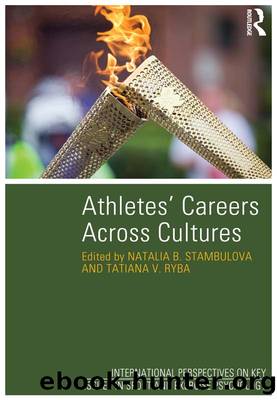Athletes' Careers Across Cultures by Stambulova Natalia B.;Ryba Tatiana V.;Stambulova Natalia B.;Ryba Tatiana V.;

Author:Stambulova, Natalia B.;Ryba, Tatiana V.;Stambulova, Natalia B.;Ryba, Tatiana V.;
Language: eng
Format: epub
ISBN: 1211734
Publisher: Taylor & Francis Group
Athletic retirement of Japanese athletes
To some degree, we may say that research on an athlete's career termination and retirement in Japan has just started (Takahashi, 2011). An overview of distinctive studies and publications on the topic follows.
Yoshida, Yamamoto and Tatano (1999) and then Toyoda and Nakagomi (2000) reviewed the results of previous international research on athletic retirement since the 1950s. Toyoda and Nakagomi pointed out the following three stages of change that have taken place. The first stage (1950s to 1970s) is characterized by attempts to understand athletes' psychological and sociological problems with regard to retirement from competition. During the second stage (1970s to 1980s) attempts were made to specify the factors which influenced problems with adaptation to life after athletic retirement. During the third stage (from the late1980s onwards) research has focused on intervention methods.
Toyoda (1999, 2007) and Toyoda and Nakagomi (1996, 2000) also pointed out that athletic retirement is a process during which it is possible to expect development and growth rather than just difficulties. They insist that athletes should not rely only on external assistance but should also make their own efforts towards creating their second careers. Athletes have to resolve complicated and multidimensional problems when facing retirement. In order to understand them, it is necessary to approach athletes who have actually retired using a case study approach.
Shigeno (2010) created several recommendations for Japanese professional football players facing retirement from competition based on the role of exit theory (Ebaugh, 1988) and a case study approach. Shigeno was himself a prominent professional football player and, after retirement, he became a staff member of the J League (Japanese Professional Football League) Career Support Center. He recommended that players should try to secure high professional status to ensure their place in the team, but should also think about life after retirement while they were still active athletes. To be better prepared for termination of the football career, Shigeno recommended that the players receive proper education during their youth period and participate in career support seminars when free from competitions. Ogawa (2010) added that Japanese professional football players facing a career-ending transition should be connected to human resources (e.g. sport psychologists/career consultants) to support them.
Toyoda (2008) carried out a study that focused on the developmental tasks confronted by Japanese ex-Olympians and their coping behaviors. He conducted semi-structured interviews with five Japanese ex-Olympians who retired from their athletic career more than twenty years prior to the data collection. All of them were females who had very similar backgrounds â they were all handball players, participated in the 1976 Montreal Olympic Games and experienced career transition in their twenties. They all shared their memories about their transition experiences, which were in a way similar but also different. There were two major findings of this study. The first one was related to the following set of three developmental tasks faced by ex-Olympians after termination in sports: (1) identity change, (2) life style change, (3) cultivation of new relationships. Specifically, these tasks interacted with each
Download
This site does not store any files on its server. We only index and link to content provided by other sites. Please contact the content providers to delete copyright contents if any and email us, we'll remove relevant links or contents immediately.
Unwinding Anxiety by Judson Brewer(72699)
The Art of Coaching by Elena Aguilar(52869)
The Fast Metabolism Diet Cookbook by Haylie Pomroy(21037)
Rewire Your Anxious Brain by Catherine M. Pittman(18515)
Healthy Aging For Dummies by Brent Agin & Sharon Perkins RN(16983)
Talking to Strangers by Malcolm Gladwell(13170)
The Art of Thinking Clearly by Rolf Dobelli(10167)
Crazy Rich Asians by Kevin Kwan(9143)
Mindhunter: Inside the FBI's Elite Serial Crime Unit by John E. Douglas & Mark Olshaker(9142)
The Compound Effect by Darren Hardy(8768)
Tools of Titans by Timothy Ferriss(8178)
Periodization Training for Sports by Tudor Bompa(8128)
Becoming Supernatural by Dr. Joe Dispenza(8071)
Wonder by R. J. Palacio(7932)
Crystal Healing for Women by Mariah K. Lyons(7841)
Bodyweight Strength Training by Jay Cardiello(7822)
Therapeutic Modalities for Musculoskeletal Injuries, 4E by Craig R. Denegar & Ethan Saliba & Susan Saliba(7675)
Change Your Questions, Change Your Life by Marilee Adams(7595)
Should I Stay or Should I Go? by Ramani Durvasula(7535)
